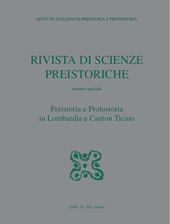Sulla gestione e valorizzazione dei siti UNESCO preistorici in Lombardia
P. 785-794
Among the current Italian UNESCO sites, 10 are placed in Lombardy and 2 of them are prehistoric cultural sites: rock art of Valle Camonica and the pile dwellings around the Alps. This paper shows the management of the two sites (one linked to a Lombard valley and the other to an international context) and some examples of enhancement. The site no. 94 “Rock Art of Valle Camonica”, inscribed in 1979 as the first Italian UNESCO site, was provided with a Management Plan in 2005, coordinated by the Superintendence for Archaeological Heritage of Lombardy in close collaboration with the Local Authorities. Now the management is carried out by the Institutional Coordination Group (GIC), a working group established in 2006 with the peripheral Offices of Ministero per i Beni e le Attività Culturali, the Municipalities where the rock art parks are placed and the Comunità Montana della Valle Camonica (Reference Office).
Among the main projects of enhancement, there are structure accommodations for eight parks, for new sites and plurithematical routes. One of the main projects of the Management Plan was the MUPRE-National Museum of Prehistory of Valle Camonica, opened in 2014: with its archaeological finds, it integrates the rich heritage of engravings and offers a wider image of the history of the valley. The serial transboundary UNESCO site “Prehistoric Pile Dwellings around the Alps” was inscribed in 2011 and until now it is the most complex Italian transboundary site because it involves, in addition to Switzerland (submitting State), France, Austria, Germany, Slovenia and Italy. The serial property is composed by 111 component parts and the Italian ones are 19, spread in Piedmont (2), Lombardy (10), Trentino Alto Adige (2), Veneto (4) and Friuli Venezia Giulia (1).
The management is carried out at an international level through the International Coordination Group (ICG). Since 2011, the coordination of the Italian part has been managed by the Archaeological Superintendence of Lombardy because of its geographic location and the number of the pile dwellings in its territory. It was supported by a Technical Group with representatives of other Superintendences, Regions, Civic Museums and experts. The Superintendence was also the Reference Office and the Co-Financing Office for the Project to carry out the Italian Management Plan (Law 77/2006, Financial Year 2013).
This composite project is still ongoing, although the Reorganization of the Ministero has led to a change of the Peripheral Offices' system, with the establishment in Lombardy of 4 Soprintendenze Archeologia Belle Arti e Paesaggio. Projects for protection, research and enhancement have been realized often with the financial support of Regions and local Municipalities. The pile dwellings are under water or in bogs and, therefore, they are ideal for the preservation of finds in organic materials, but it is hard to enhance them. For this reason, besides a closer connection with the museums that show archaeological finds, it is necessary to find new ways to communicate their outstanding value. [Publisher's text]
-
Articoli dello stesso fascicolo (disponibili singolarmente)
-
Informazioni
Codice DOI: 10.32097/1210
ISSN: 2282-457X


